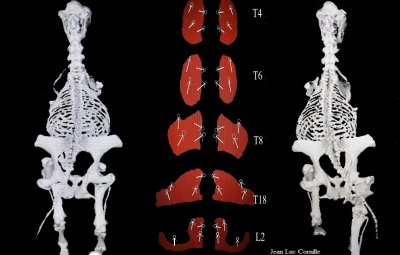Science: Cutting Age of Better Riding
Science; Cutting Age of Better Riding
or
Portal of Old Beliefs?
Lightness, which is the outcome of balance, is about converting the hind legs thrust into upward forces. The push of the left hind leg and the right hind leg's propulsive activity induces oblique forces on the thoracolumbar spine that are converted by the back muscles into forward motion (horizontal forces) and balance control (upward forces). Lightness is the outcome of this subtle muscular work.

The red elements are cross-sections of the longissimus dorsi at the level of T4, T6, T8, T18, and L2 between the two skeletons. The arrows illustrate the direction of the forces produced by the muscles in motion. The forces are not even in the direction of the fascicles. The general consensus is that the fascicles' geometry within a muscle determines how the fascicles lengthen and shorten. At the point of actual knowledge, it is demonstrated that the fascicles coordinate their action to create forces related to motion that are not in the direction of the fascicles. This raises pertinent questions; how are we going to orchestrate this muscular work with our rein effects, leg action, a shift of our body, neck posture, stretching, relaxation? It looks like equestrian theories belong to a world that is not related to the horse's physique's actual functioning
There is no mechanical way to orchestrate the work of the horse's back muscles. It can only be done through an intelligent and respectful conversation. We can create a balance, a frequency, a posture, use a movement that might lead the horse's brain toward proper coordination of his physique. Still, the success is in the conversation about moving from natural reflexes to efficient muscle work. The horse naturally protects his actual muscle imbalance. His initial response is a compromise between his willingness to try and his instinctive protective reflex mechanism. These two elements are the basis of our conversation. We need knowledge, the coordination of the horse's physique best adapted to the effort. We need respect; the horse's reactions are legitimated. We need a mindset on partnership. We need a language updated to actual knowledge. There is one neuron per muscle, but the brain could not compute all the body motion complexity. Physical intelligence eases the work of the brain, creating synergies, muscles working together while doing their own work. The horse brain coaches the synergies for greater efficiency, and we coach the horse's brain.
Lightness is a horse's physique capable of converting the hind legs' thrust into balance control, forward motion, straightness, maximum use of elastic energy through tendons, aponeurosis, fascia. Knowledge has evolved from the longissimus dorsi, illustrated like a long bungee cord stretching from the neck to the croup. These primitive illustrations engendered simplistic equitation.  The brain maps the body all at once, and while traditional thinking believes that refining the touch of the horse's body parts might coordinate the whole physique, neurophysiology suggests that, on the contrary, the precision of one body part results from the refined orchestration of the entire physique. Valid for the horse, true for the rider. Our whole body converses all at once, and even if we feel a shift of the horse's right shoulder, we must not think right shoulder but instead refine the overall coordination of the horse's physique that will realign the right shoulder.
The brain maps the body all at once, and while traditional thinking believes that refining the touch of the horse's body parts might coordinate the whole physique, neurophysiology suggests that, on the contrary, the precision of one body part results from the refined orchestration of the entire physique. Valid for the horse, true for the rider. Our whole body converses all at once, and even if we feel a shift of the horse's right shoulder, we must not think right shoulder but instead refine the overall coordination of the horse's physique that will realign the right shoulder.
During the Lightness Forum, I referred to one of Chazot's reactions shifting his right shoulder lightly. Working on the half pass, I guided his brain toward a better "solution," enhancing the balance. This might look mystical and even scary because there is no formula. The horse does not understand formulas; instead, he perceives subtle nuances in our physique. For the horse, tensegrity is natural; it is part of his umwelt. Gestures are gross and meaningless. For the rider, we are born with a sacred gift, intuition, and we have the capacity to identify the source of the horse's difficulty following our intuition. But, because intuition is not infallible, we are criticized for our errors and lose faith in our intuition. There is one formula that is working very well, "intuition and sense of humor." The ones who have lost their sense of humor develop a large sense of self-importance. Humor keeps us humble and, therefore, intelligent enough to listen to the horse.
Jean Luc


 twitter
twitter facebook
facebook google
google pinterest
pinterest yahoo
yahoo linkedin
linkedin